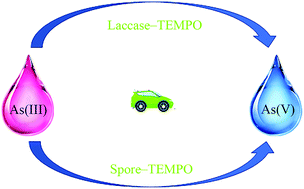Rapid catalytic oxidation of As(iii) to As(v) using a Bacillus spore–2,2,6,6-tetramethylpiperidine-1-oxyl system
Abstract
The oxidation of As(III) to As(V) is a critical process in the treatment of contaminated water. We found that 95% As(III) (10 mg L−1) could be rapidly oxidized to As(V) by a laccase–2,2,6,6-tetramethylpiperidine-1-oxyl (TEMPO) system in 1 h. Based on this finding, we used Bacillus subtilis spores instead of laccase for As(III) oxidation with the same effect because the former had plenty of CotA–laccase on their surface. The catalytic ability of CotA protein and spores was confirmed by expressing the CotA protein and knocking out the cotA gene from wild-type spores. Both laccase– and spore–TEMPO systems displayed similar oxidation rate constants, Michaelis–Menten constants, and maximal velocities owing to the formation of the oxoammonium cation of TEMPO in the presence of dissolved oxygen. Several other laccase mediators such as 2,2′-azino-bis(3-ethylbenzothiazoline-6-sulfonic-acid) (ABTS), acetosyringone (AS), 1-hydroxybenzotriazole (HBT), 2-hydroxybutyl acrylate (HBA), violuric acid (VLA), 4-oxo-TEMPO, 4-amino-TEMPO, 4-methoxy-TEMPO, 4-hydroxy-TEMPO benzoate, and 4-hydroxy-TEMPO coupled with spores for As(III) oxidation were also investigated in detail. The spore–TEMPO system exhibited the highest oxidation efficiency and tolerated the addition of 10 mg L−1 Al3+, Ti4+, Cu2+, K+, Fe3+, Zn2+, Ni2+, Mg2+, Co2+, and Mn2+. Both laccase and spores recovered via ultrafiltration and centrifugation, respectively, could be reused for at least five cycles. The developed spore-based system has several advantages including eco-friendliness, ease of operation and storage, low cost, recyclability, sustainability, and without the need for enzyme purification. These findings may have promising implications for developing a new eco-friendly and cost-effective technology for the treatment of arsenic-containing water.



 Please wait while we load your content...
Please wait while we load your content...